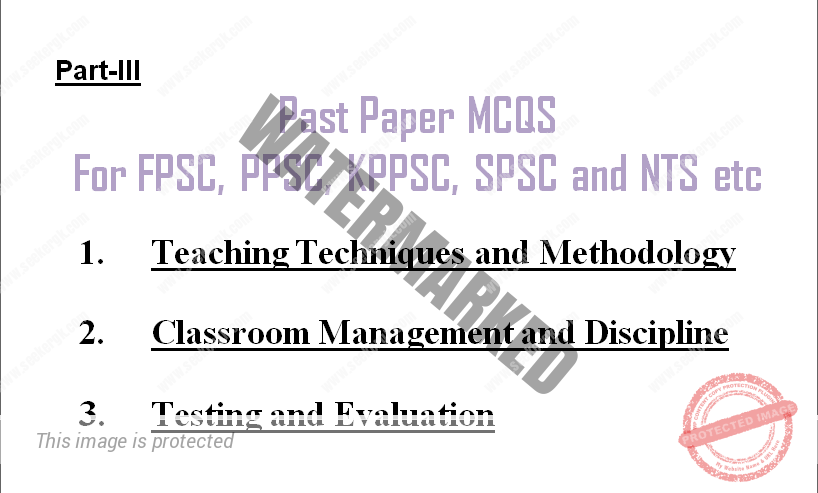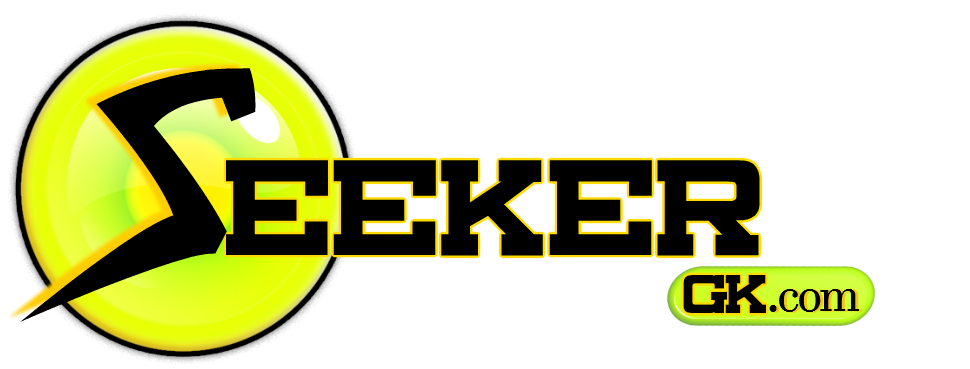
TEACHING MCQs With Solved Answers
1. In teaching experienced members guide the immature one’s for
(a) Spending time
(b) Qualification
(c) Quality of life
(d) Adjustment of life
2. Which is not the focal point of triangular process of teaching
(a) Teaching method
(b) Teacher
(c) Pupil
(d) contents
3. The goal of teaching is
(a) to give information
(b) To involve pupils in activities
(c) To impart knowledge
(d) Desirable change in behavior
4. The rules of presenting the contents to make them easy are called
(a) Method of teaching
(b) Maxims of teaching
(c) Techniques of teaching
(d) Teaching strategies
5. SOLO stands for
(a) System of the observed learning outcome
(b) structure of the observed learingn output
(c) Structure of the observed learning outcome
(d) System of the observed learning output
6. SOLO taxonomy consists of levels
(a) 2
(b) 3
(c) 4
(d) 5
7. With reference to solo taxonomy one aspect of a task is understood in
(a) Unistructural level
(b) Multistructural level
(c)Rational level
(d) Extended abstract level
8. Two or more aspects are understood in
(a) Unistructural lever
(b) Multistructural level
(c)Rational level
(d) Extended abstract level
9. Integration is developed between two or more Aspects in
(a) Unistructural level
(b) Multistructural level
(c)Rational level
(d) Extended abstract level
10. To go beyond the given in formation is
(a) Unistructural level
(b) Multistructural level
(c)Rational level
(d) Extended abstract level
11. SOLO taxonomy was presented by
(a) Bloom
(b) Krath whol
(c)Simpson
(d) Biggs & collis
12. Students are passive in
(a) Project method
(b) Discovery method
(c)Lecture method
(d) Inquiry method
13. Symposium is a type of
(a) Discovery method
(b) Discussion method
(c)Lecture method
(d) Demonstration method
14. Heuristic means
(a) To investigate
(b) To show
(c)To do
(d) To act
15. Arm strong was the exponent of
(a) Problem solving method
(b) Project method
(c)Discussion method
(d) Heuristic method
16. According to Kilpatrick, the types of projects are
(a) 2
(b) 3
(c)5
(d) 5
For more Visit now Www.seekergk.com
17. Activity involves
(a) Physical action
(b) Mental action
(c)Mental action
(d) Physical and mental action
18. We move from specific to general in
(a) Inductive method
(b) Deductive method
(c)Drill method
(d) Discussion method
19. Practice is made in
(a) Inductive method
(b) Deductive method
(c)Drill method
(d) Discussion method
20. The Socratic method is known as
(a) Lecture demonstration method
(b) Discussion method
(c)Inquiry method
(d) Question- Answer method
21. Which is not true about projects
(a) It is a purposeful activity
(b) It is proceeded in social environment
(c)It is accomplished in real life
(d) It is teacher centred activity
22. Duration of lessons in macro- lesson plans is
(a) 5-10 min
(b) 10-20 min
(c)20-30 min
(d) 35-45 min
23. In British approach of lesson planning, more emphasis is on
(a) Activity
(b) Teacher
(c)Content presentation
(d) Teacher and content presentation
24. American approach emphasizes
(a) Teacher
(b) Content presentation
(c)Learning objectives
(d) Methods
25. Which one is not the type of lesson plans on the basis of objectives
(a) Micro lesson plan
(b) Cognitive lesson plan
(c)Affective lesson plan
(d) Psychomotor lesson paln
26. Which is not true about lesson plan
(a) It is develops confidence
(b) It helps in orderly delivery of contents
(c)It is developed by students
(d) It saves from haphazard teaching
27. A good drama does not include
(a) Interesting story
(b) Alive dialogues
(c)Very long play
(d) Subject full of feelings
28. Which is not the objective of Drama/ role play
(a) Recreation and enjoyment
(b) Development of social skills
(c)Development of skills of conversation
(d) Do make rehearsals
29. Drama or role play is useful for teaching
(a) History
(b) Science
(c)Malts
(d) Language
30. The main types of teleconferencing identified are
(a) 2
(b) 3
(c) 4
(d) 5
31. Which is not the types of teleconferencing
(a) Audio teleconferencing
(b) Video teleconferencing
(c)T.V teleconferencing
(d) Computer teleconferencing
32. Which one is accountable in cooperative learning
(a) Individual
(b)Group
(c) Both a & b
(d) None of a & b
33. Cooperative learning is an alternative to
(a) competitive models
(b) Teaching models
(c)lesson plans
(d)Micro teaching
34. The number of students in cooperative learning groups are
(a) 3-4
(b) 5-6
(c) 8-10
(d) 10-15
35. The essential characteristic of cooperative learning is
(a) Effective learning
(b)Positive interdependence
(c)Cooperation
(d) Division of labour
36. The students like to spend the most of the time with
(a) Teachers
(b) parents
(c) Relatives
(d) Peers
37. Peer culture constitutes
(a) Socialization
(b) Individualization
(c) Both a & b
(d) None of a & b
38. Which is not the advantage of team teaching
(a) Better utilization of resources
(b) Better planning
(c) Better use of teaching techniques
(d) Better financial benefits of teachers
39. The hypothesis underlying team teaching is
(a) Teachers feel bore while working alone
(b) Teachers are not competent
(c) The best teachers in schools are shared by more students
(d) The single teacher cannot control the class
40. CAI stands for
(a) Computer analyzed instruction
(b) Computer assisted instruction
(c) Computer assisted interview
(d) Computer analyzed interview
41. Which is not the mode of CAI
(a) Tutorial mode
(b) Drill mode
(c) Simulation mode
(d) Question mode
42. Example of psychomotor domain is that student
(a) Demonstrates awareness to environmental pollution
(b) Performs an experiment
(c) Can computer results of two experiments
(d) Can narrate a story
43. Ability to develop a life style based upon the preferred value system is
(a) Responding
(b) Valuing
(c) Organizing
(d) Characterizing
44. Example of cognitive domain is
(a)Describe a topic
(b) Develop an X-ray film
(c) Type a letter
(d) Take responsibility for tools
45. At the highest level of hierarchy is
(a) Understanding
(b) Application
(c) Evaluation
(d) Analysis
For more Visit now Www.seekergk.com
46. Student can design a laboratory according to certain specification in which category of objective?
(a) Analysis
(b) Synthesis
(c) Evaluation
(d) Knowledge
47. The number of domains in taxonomies of educational objective is
(a) Tow
(b) Three
(c) Five
(d) Six
48. The highest level of cognitive domain is
(a) Synthesis
(b) Analysis
(c) Comprehension
(d) Evaluation
49. The process of determining the value or worth of anything is
(a) Test
(b) Measurement
(c) Assessment
(d) Evaluation
50. Educational objectives have been divide into
(a) Two domains
(b) Three domains
(c) Four domains
(d) Five domains
51. Taxonomy of educational objectives was presented in
(a) 1946
(b) 1956
(c) 1966
(d) 1976
52. The classification of cognitive domain was presented by
(a) Benjamin S. Bloom
(b) Skinner
(c) Krathwhol
(d) Simpson
53. Cognitive domain have
(a) Three subgroups
(b) Four subgroups
(c) Five subgroups
(d) Six subgroups
54. The lowest level of learning in cognitive domain is
(a) Comprehension
(b) Application
(c) Knowledge
(d) Synthesis
55. The highest level of learning in cognitive domain is
(a) Evaluation
(b) Synthesis
(c) analysis
(d) Application
56. The right sequence of subgroups cognitive domain is
(a) Knowledge, Comprehension, Application, Synthesis, analysis, Evaluation
(b) Knowledge, Comprehension, application, Evaluation, analysis, Synthesis
(c) Knowledge, Comprehension, Evaluation, application, Analysis, Syntesis
(d) Knowledge, Comprehension, application, analysis, Synthesis Evaluation
57. Knowing/ memorizing and recalling is concerned with
(a) Cpmprehension
(b) Application
(c) Knowledge
(d) Evaluation
58. To grasp the meaning of the material is
(a) Comprehension
(b) Applicatin
(c) Knowledge
(d) Synthysis
59. To use previous learned material in new situation is
(a) Comprehension
(b) Application
(c) Knowledge
(d) analysis
60. To break down material into component parts to know its organizational structure is
(a) Comprehension
(b) application
(c) Analysis
(d) Synthesis
61. To put ideas together to form a new whole is
(a) Evaluation
(b) Synthesis
(c) Analysis
(d) Application
62. To know the worth or value of material is
(a) Analysis
(b) Application
(c) Knowledge
(d) Evaluation
63. The intellectual skills are reflected by
(a) Cognitive Domain
(b) affective domain
(c) Psychomotor
(d) None of above
64. Attitudes, values and interests are reflected by
(a) Cognitive Domain
(b) Affective Domain
(c) Psychomotor Domain
(d) None of above
65. Which domain is concerned with physical and motor skills?
(a) Cognitive Domain
(b) Affective Domain
(c) Psychomotor domain
(d) None of above
66. The focus of cognitive domain is
(a) Physical and Motor skills
(b) Intellectual Skills
(c) Attitudes and Interests
(d) None of above
67. The affective domain was classified by
(a) Benjamin S. Bloom
(b) Simpson
(c) Krathwohl
(d) Burner
Answer is =c
68. Affective domain is divided into
(a) four subgroups
(b) Five subgroups
(c) Six subgroups
(d) seven subgroups
69. The lowest level of learning in affective domain is
(a) Responding
(b) Valuing
(c) Attending
(d) Organization
70. Which is placed at the highest level of learning in affective domain
(a) Attending
(b) Responding
(c) Organization
(d) Characterization
71. Right order of sub- groups of affective domain is
(a) Attending, Responding, Valuing, characterization, Organization
(b) attending, Responding, Characterization, Valuing, Organization
(c) Attending, Valuing, Responding, Organization, Characterization
(d) Attending, Responding, Valuing, Organization, Characterization
72. Willingness to attend to particular phenomenon is
(a) Attending/ Receiving
(b) Responding
(c) Valuing
(d) Organization
73. Which sub- group of affective domain focuses on active participation in
(a)Attending/ Receiving
(b) Responding
(c) Valuing
(d) Organization
74. Bringing together different values into a consistent value system is
(a) Attending/ Receiving
(b) Responding
(c) Valuing
(d) Organization
75. Affective domain focuses on adoption of a value system as a part of life style in
(a) Responding
(b) Valuing
(c) Organization
(d) Characterization
76. Psychomotor domain was classified by Simpson in
(a) 1962
(b) 1972
(c) 1982
(d) 1992
77. Affective domain was divided into subgroups by Krathwohl in
(a) 1954
(b) 1964
(c) 1974
(d) 1984
78. Psychomotor domain was divided by Simpson in
(a) Four subgroups
(b) Five subgroups
(c) Six subgroups
(d) Seven subgroups
79. The Characteristic of behavioral objective is
(a) Observable and Immeasurable
(b) Non- observable
(c) Observable and measurable
(d) None of above
80. The right sequence of sub-groups of psychomotor domain is
(a) Perception, Set, Guided response, Mechanism, Complex overt response, adaptation, Origination
(b) Perception, Complex over response, Set, Guided, response, Mechanism, adaptation, Organization
(c) Set, Origination, Guided response, Mechanism Complex overt response, Adaptation, perception
(d) Guided response, Mechanism, perception, Set, Adaptation, Organization, Complex overt response
81. Objective related to affective domain is
(a) Student can paint a picture
(b) Student can draw a graph
(c) Student values honesty
(d) Student can write a letter
82. Bring together scientific ideas to form a unique idea is
(a) Application
(b) analysis
(c) Synthesis
(d) Evaluation
83. Which is vast in scope
(a) Teaching tactic
(b) Teaching Technique
(c) Teaching Strategy
(d) Teaching Method
84. Students find/explore the in formations themselves in
(a) lecture method
(b) Discovery method
(c) Both
(d) none
85. Teacher performs practically and explains in
(a) Lecture method
(b) discovery method
(c) demonstration method
(d) Problem solving method
86. Role of student is active in
(a) Discover method
(b) Problem solved method
(c) Inquiry method
(d) All above
For more Visit now Www.seekergk.com
87. Micro teacher is a
(a) Teacher method
(b) Teaching training technique
(c) Motivational technique
(d) none of above
88. What is the tie of presentation in Micro teaching?
(a) 1-5 min
(b) 5-10 min
(c) 10-15 min
(d) 15-20 min
89. What is the No of students in micro teaching?
(a) 1-5
(b) 5-10
(c) 10-15
(d) 15-20
90. Micro teaching started in
(a) 1950
(b) 1960
(c) 1970
(d) 1980
91 Micro teaching focuses on the competency over
(a) Method
(b) Skills
(c) Contents
(d) None of above
92. Which is more suitable in teaching of science?
(a) Lecture method
(b) demonstration method
(c) Discussion method
(d) Project method
93. Which one is exception?
(a) Books
(b) Magazine
(c) Diagrams
(d) T.V
94. Which is not included in print media?
(a) Books
(b) Magazine
(c) Diagrams
(d) T.V
95. How many senses a person uses while observing film?
(a) 1
(b) 2
(c) 3
(d) 4
96. How much knowledge is gained through the sense of seeing?
(a) 75%
(b) 13%
(c) 6%
(d) 3%
97. How much knowledge is gained through the sense of listening?
(a)75%
(b) 13%
(c) 6%
(d) 3%
98. How much knowledge is gained through the sense of touch?
(a)75%
(b) 13%
(c) 6%
(d) 3%
99. How much knowledge is gained through the sense of smell?
(a) 75%
(b) 13%
(c)6%
(d) 3%
100. How much knowledge is gained through the sense of taste?
(a)75%
(b) 13%
(c) 6%
(d) 3%
101. According to W. Therber,types of Models are
(a)2
(b) 3
(c) 4
(d) 5
102. Mock up models are those which explain
(a) Principles or working of machine
(b) Internal structure
(c) External structure
(d) None of above
103. A field trip is arranged for
(a) Making an excursion
(b) See other people doing things
(c) Note the meaning of action
(d) all of the above
104. Interest can be created in students in specific topics of study be the use of
(a) Chalk board
(b) Fellalin
(c) Bulletin board
(d) All of above
105. The most direct experience from the following is that of
(a) Motion pictures
(b) Visual symbol
(c) Demonstration
(d) field trip
106. What is true about science Text Book?
(a) There is no difference between textbook and curriculum
(b) Our teachers take textbook as curriculum
(c) Our teacher do not take textbook as a part curriculum
(d) Textbook does not help in the selection of instructional activities
107. Which one is a standard for demonstration method?
(a) Student should observe the demonstration and teacher should not tell important finding
(b) To keep accuracy of results the teacher should dictate the result
(c) Demonstration should be pre- tested to remove the weakness in demonstration
(d) all of the above
108. Wragg has suggested how many numbers of students in a micro teaching class?
(a) 33 to 40
(b) 25 to 30
(c) 15to 20
(d) 5 to10
109. What is the merits of microteaching?
(a) Feedback helps in the improvement of method of teaching
(b) Due to shortage of time you divide the lesson plan into small units and thus gain mastery over the content
(c) It helps in self evaluation and teacher build up confidence in them
(d) all of the above
110. Method is based on the facts that students learn association, activity and cooperation is know as
(a) Demonstration
(b) Project
(c) Problem- solving
(d) discussion
111. Exhibition of Science fairs promote students ability of
(a) Knowledge order skills
(b) Comprehension and application
(c) Higher order skills
(d) Homer order skills
112. The ultimate focus of scientific method is on
(a) Hypothesis formulation
(b) Observation
(c) Experimentation
(d) Formulation of a law theory
113. What is the first step in the project method of teaching
(a) Determination of activities
(b) Determination of objectives
(c) Planning
(d) distribution of work
For more Visit now Www.seekergk.com
114. Which one is NOT the Psychological principle of teaching?
(a) Proceed from concrete to abstract
(b) Proceed from complex to simple
(c) Proceed from known to unknown
(d) Proceed from simple to difficult
115. Which is the SECOND step in the problem solving method?
(a) Testing hypothesis
(b) Recognition and definition of problem
(c) Conclusion
(d) Formulation of hypothesis
116. Which is the best method of teaching Science at school level?
(a) Lecture
(b) Analytical
(c) direct
(d) Demonstration
117. Which is not the step of scientific method?
(a) Observation
(b) Experiment
(c) Prediction
(d) Interview
118. The ultimate result of scientific method is
(a) Development of knowledge
(b) Development of senses
(c) Both a & b
(d) None of a & b
119. Aims are
(a) National expectations
(b) Institution expectations
(c) Learning expectations
(d) None of the above
120. Goals are at
(a) National level
(b) Subject level
(c) Classroom level
(d) All of the above
121. Objectives are at
(a) National level
(b) Subject level
(c) Classroom level
(d) All of the above
122. To promote science and technology is
(a) Aim
(b) Goals
(c) Objective
(d) All of the above
123. To important computer education is
(a) Aim
(b) Goal
(c) Objective
(d) All of the above
124. To identify the parts of the computer is
(a) Aim
(b) Goal
(c) Objective
(d) All of the above
125. “State first law of motion” indicates
(a) Knowledge
(b) Comprehension
(c) application
(d) Evaluation





Thanks.
Helping Material, Thanks!
this mcq session is very helpful and informative
Please send me the book kindly